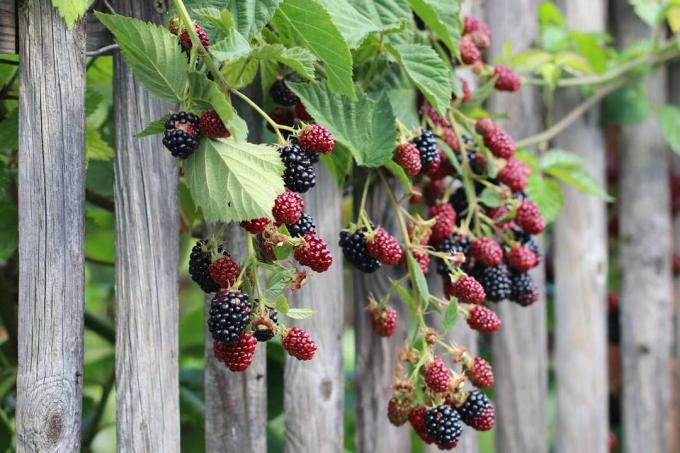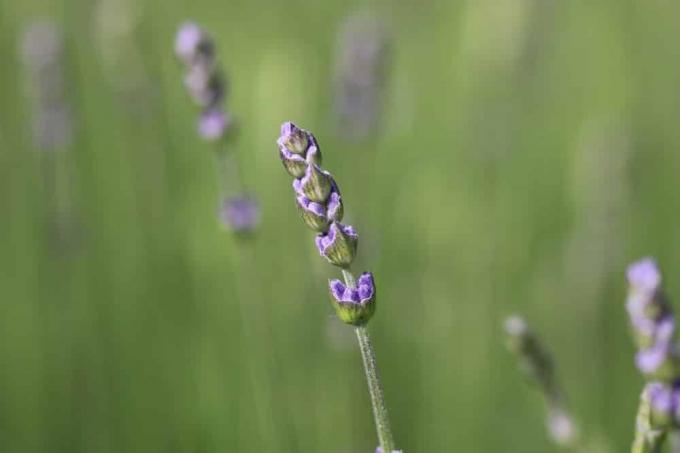

Table of contents
- When is the best time?
- Instructions for pruning
- Preservation Pruning Guide
- Taper Cut Instructions
- care mistakes
- Once blooming climbing roses
- Climbing roses that bloom more often
Depending on the variety, you can only cut the climbing roses once or several times a year. Proper pruning is important for care and is crucial for beautiful growth, lush growth and attractive flowering. Young plants should not be pruned so that they can develop undisturbed.
When is the best time?
Faced with wilted roses, many gardeners want to start pruning in the fall to prune the plant and shape it to the desired shape. However, this point in time is fatal for the plants, because in this phase the urgently needed nutrients flow back from the leaves into the shoots. In this way, the roses strengthen themselves for the winter and increase their resistance to the impending temperature drops. As an orientation for the right time, the forsythia blossom offers a useful hint. When their yellow flowers begin to sprout, the climbing roses can be cut safely.
- The best time for pruning is early spring
- Only cut back after the last frosty nights
- In mild winter conditions, prune as early as late winter
- Only cut back climbing roses from the second or even third year of life
- If possible, do not prune annual shoots
- Cut once-flowering climbing roses only once a year
- Prune more frequently flowering varieties up to three times a year
- Never reach for rose scissors in autumn
- Autumn pruning only weakens the roses unnecessarily
Instructions for pruning

Climbing roses grow both in height and in width and can reach large dimensions. They can be created in many forms, for example as a rose arch. The flowers captivate with their varied blaze of colour, some varieties even bloom several times a year. However, the gardener has to intervene to regulate with a pruning, otherwise the flowering splendor of the climbing artists cannot unfold in the long term.
In addition, regular pruning prevents the shoots from becoming longer and weaker. In addition, with a correct pruning, the development of the flowers is promoted and the roses develop significantly more foliage.
- Only shorten the two to three year old shoots
- Leave 3-5 eyes on the rose shoot
- Remove old shoots in favor of young shoots
- Cut off diseased shoots in good time
- Always cut back slightly at an angle
- Cut about 5 mm above the knot
- Always trim above the outward facing eye
- Put the scissors as close as possible to the trunk
- Special rose scissors are ideal
- Disinfect and sharpen tools well before use
Preservation Pruning Guide
The aim of this pruning is to preserve the healthy and vital properties of the climbing roses. The focus is on optimizing the growing conditions at hand to encourage beautiful flowering. The winter and its extreme weather conditions put a strain on the plant and often cause damage. Damaged plant parts are often the cause of the beginning of balding or senescence, which leads to unsightly growth.
Maintenance pruning is a good time to check the climbers for any fungal or pest infestation. If the first small signs of this already appear, then the affected parts of the plant should be removed generously. This is the only way to prevent further spread and nip it in the bud.
- Long-lasting frost and heavy hail often cause damaged shoots
- Generously remove damaged shoots
- Cut dry and old branches right at the base
- Cut off stunted branches
- Prune shoots that grow too much inwards
- Remove criss-crossing branches
- Cut only perennial rose shoots
- Two- and three-year-old twigs clip down to 3 to 5 eyes
- Do not prune annual branches
- Tie them down with a climbing aid
- Do not dispose of diseased or infested clippings in the compost
- Dispose of with household waste to prevent further spread
Tip:
Note in particular that the bushy growth of the climbing roses looks very unusual. To promote this, you should repeatedly attach the annual shoots either horizontally or at an angle to the rose trellis.
Taper Cut Instructions

In the case of climbing roses, it is desirable for them to climb up and down. The goal is a densely overgrown rose trellis or a colorful display of flowers on the rose arch. In order to achieve this, the climbing artists need appropriate care steps that differ from normal rose bushes. For this reason, these special roses must be pruned regularly to maintain their health and sprout vigorously.
Only in this way will the plant put its energy into young shoots and not into the growth of old branches. Otherwise, the older branches will stretch out more and more and become much too thin. The growth appears uneven and the flower is poor. The result is aging plants that can only bloom at the tips of the branches. In addition, the roses are weakened without pruning and are therefore more susceptible to pests and fungal infestation.
- Prune half of the perennial branches
- Shorten to about 30 cm above the ground
- Prune out too long and old branches
- Remove diseased and damaged branches
- Shorten lateral and short shoots to 2 eyes
- Cut off the rest of the old branches the following year
- Perform rejuvenation pruning especially on neglected plants
- At the same time remove wild shoots
- Carefully uncover rootstock
- Tear off water shots with a courageous grip
care mistakes
Incorrect pruning weakens the plant's immune system and makes it more susceptible to disease and pest infestation. The right time also plays an important role, this depends on the rose variety and should be found out before pruning. Since the plants have no adhesive roots, they use their thorns as climbing aids.
If there is not enough support, the branches can quickly break off in strong winds. In addition, roses need their rest at the end of the year in order to be able to recharge important energies.
- Avoid stunted branch stumps
- Prune only when absolutely necessary
- Do not prune young plants in the first year
- Choose a suitable surface, not all places are suitable
- Do not forget stable climbing aids
- Avoid exposed locations with a lot of wind
- Do not use dirty tools, disinfect with alcohol
- Do not use blunt pruning shears, sharpen before use
- Never prune in the fall
- Do not leave faded plant parts on the plant for too long
Once blooming climbing roses

Once blooming varieties include most rambler roses. These have a particularly strong growth and can reach heights of more than six meters. Therefore, these varieties are ideal for house walls and tall trees. But the rambler roses also look very unusual on a rose trellis with their flat growth, in which the flowers come into their own.
Since the lower parts of the plant are usually also leafy, there are no bare and unsightly areas. These properties are ideal for creating a privacy screen. In the case of very tall specimens, cutting back in summer poses a safety risk and reduces flowering.
- In spring, a small and shaping basic cut is sufficient
- Do not bloom on new shoots
- Flowering side shoots only form from the perennial long shoots in the following year
- Only cut back climbing roses that bloom once after flowering
- To do this, shorten most of the main shoots that have already flowered
- Remove young shoots that are too weak and faded plant parts
- Tie all other branches to the trellis
- Determine the shape you want
- Tie shoots loosely distributed upwards
- Always pay attention to an even arrangement
- Arrange rose shoots in an arc, like a fan
A notice:
Do not cut away one-year-old and strong shoots in spring, otherwise the rose will lack the best wood for flowering.
Climbing roses that bloom more often
Varieties that flower more often bloom several times throughout the year. On the other hand, these grow much more slowly than only one-flowering varieties, because they need a lot of energy for the constant formation of the flower. More frequently flowering climbers can reach heights of two to three meters, so these are ideal for creating pergolas and rose arches.
Regularly cleaning the plants increases the willingness to bloom in roses that bloom more often. Exactly when the various prunings should be scheduled depends on the weather conditions and the willingness of the plant to bloom. In this case, the gardener should keep a regular eye on the climbing roses.
- Prune both after the first flowering and in summer
- Pruning back in summer increases flowering
- Start summer pruning more carefully
- Cut off the withered single flowers of the shorter side shoots
- Also remove faded flower clusters
- Start the cut just above the first, fully developed leaf below the flower
- In this way, the branches form new flowering shoots in the same summer
- Tie in too many young shoots between the already flowering branches
- In autumn, only shorten extremely long shoots
- These can break off due to snow and strong gusts of wind
 Home editorial office
Home editorial office
Learn more about pruning

Eucalyptus dried up: cut back now?
When a eucalyptus dries up, some owners immediately think of cutting it back. Because they want to see fresh green bud quickly. The chances of that happening may be good. But one thing must not be left out: research into the causes! Otherwise a new cycle of drying up and cutting begins.

Cut blackberries: Instructions for the right cut
Bramble branches only bear fruit for one summer, after which they are used up and die off in winter. It's a good thing that new canes grow back in time for the following year. Cutting care means: What no longer supports should be removed, young rods must be optimally trained.

cutting snowball | 13 tips for pruning
When it comes to snowballs (Viburnum), the opinions of numerous hobby gardeners differ when it comes to cutting. Main reason against pruning: Destruction of the natural appearance by pruning. Find out now when it is unavoidable and which tips should be heeded.

Cutting sage: 6 tips for cutting back
Cutting measures and their ideal time depend on the species of sage plants, because they have differentiated ways of life. There are woody and herbaceous representatives that require different attention. In order to carry out the measures, a basic set of tools is helpful.

Pruning hydrangeas: when is the right time?
Hydrangeas are a real beauty because of their flowers. In the long term, however, the flowering power is only maintained if regular pruning takes place. Because cutting off withered or dried plant parts offers protection. The following guide shows when this measure should be taken.

Cutting Lavender | When is the best time?
Lavender is a popular perennial, but difficult to cut. Without regular pruning, the shrub becomes lignified and less robust. Choosing the right time is important for pruning. When to cut depends on the use of the perennials.



